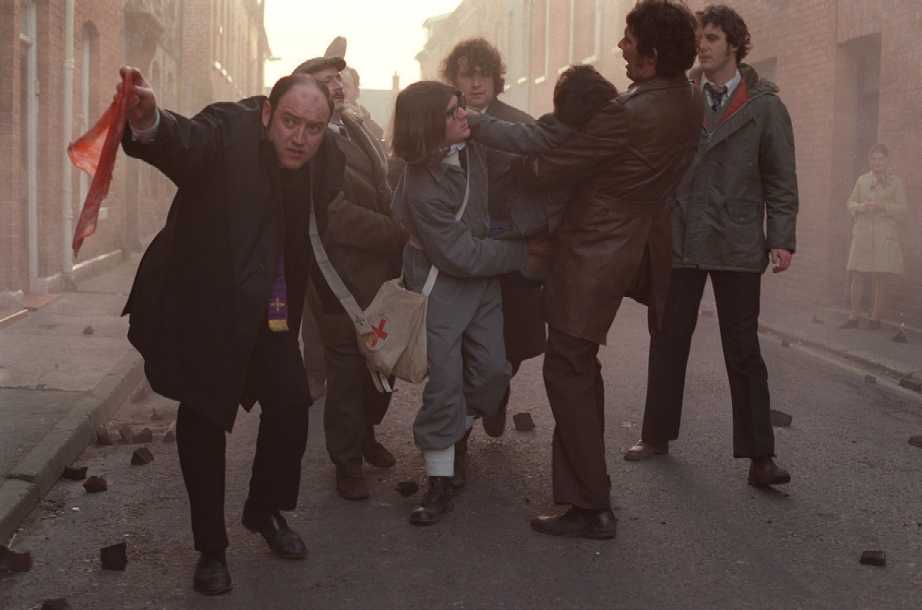
Note — This post is by Nicole Diroff, a student in the Honors College at Oakland University double majoring in philosophy and cinema studies. Over the next few months, students in my course, International Relations on Film, will be contributing posts to the blog reflecting on the movies we are watching in class. Nicole’s piece is the first, presented here with only minor editing.
“What is force?”
That was the question asked by Maj. Gen. Robert Ford when he was asked whether or not the shootings that took place on January 30, 1972, in Northern Ireland were justified, as depicted in Paul Greengrass’ film Bloody Sunday. The use of force, and what force actually is, is not only a large theme in the movie, but this question is also essential to answering some of our own problems in 2016 America.
First, even though “What is force?” is a valid question that should be answered, using it in response to a question about the shooting of a peaceful protest is completely unfair. (You can watch the entire scene from the film in the clip below.)
Asking “What is force?” in this situation completely absolves the British army from any responsibility for killing these protesters, and further can justify any action they do. Because, if they do not know what force is, there is nothing stopping them from going overboard.
However, force can be defined. And it should be divided into physical force and moral force.
Physical force is a clear concept, and it can easily be seen in the movie. It is clear that the troops attacked the protesters with violence when that level of violence was unnecessary. The paratroopers shot randomly into the crowd, and even after a ceasefire order was issued, they did not stop. A crowd of protesters ran from the shootings, but soldiers shot them from behind and even shot at them while they were down.
In this case, the question is not about what physical force actually is, but rather whether or not the force used was excessive. In short, yes, because the protesters did not pose a real threat to the troops, and also because they willfully shot at civilians.
Things change a bit when moral force is brought into the conversation, and this is also where America should reflect upon its own situation that has been happening for the past year and a half.
Moral force and physical force can be on two ends of a spectrum of force, but moral force can also be a requirement for physical force. Police officers and the military are often seen as the embodiment of a moral force, thus, when they use physical force, it must be for a good reason. However, even if they can be considered a moral force, that does not mean that society cannot be a moral arbiter itself.
The police and the military should not be the source of morality, but rather enforcers of a morality that society has already set for itself. As the topic of police brutality becomes increasingly more relevant in America, more and more people continue to state that they support the police, not criminals.
Unfortunately, this is an oversimplification of the problem. It’s easy to claim a moral person does not support criminals, but a support of criminals is not the same as not supporting the ways in which those criminals are brought to justice. Maj. Gen. Ford says in the film that everything that was done by the British Army that day was to re-establish law and order, but if the massacre of civilians is what is considered law and order, perhaps society should reevaluate what they consider to be moral.
The film did have one other example of moral force, and that was force shown through the peaceful marchers. There were certainly some in the march who became less than peaceful, but the clear objective of the march was to protest for civil rights in the name of peace.
However, as stated above, moral force seems to be some sort of prerequisite for physical force, and Bloody Sunday explores this concept in a different form, as the way the military or police would. The protesters tried to be peaceful, but the nonviolent Northern Ireland civil rights movement was killed that day along with the 13 civilians shot down on the streets by British paratroopers.
At the end of the film, Ivan Cooper, the Protestant member of parliament who was one of the organizers of the march, says at a press conference that as a result of the killings, hundreds of able-bodied men were now motivated to join the Irish Republican Army. The use of physical force has led to a circular aggression, in which each group brings violence against the other, all for the sake of trying to achieve peace.